Phân Tích Tương Lai của Đồng Tiền LUNC: Hành Trình Phi Tập Trung Từ Suy Thoái đến Xây Dựng Giảm Phát
1. Triển vọng trong tương lai của Terra Luna Classic (LUNC)
Terra Luna Classic (LUNC viết tắt) là token bản địa của blockchain Terra gốc, được sinh ra từ hệ sinh thái stablecoin theo thuật toán của Terraform Labs thành lập vào năm 2018. Trong hệ thống này, LUNC (trước đây là LUNA) duy trì sự ổn định giá thông qua cơ chế dual-token với TerraUSD (UST), một stablecoin theo thuật toán.
Tuy nhiên, vào tháng 5 năm 2022, hệ sinh thái Terra đã gặp phải một sự sụp đổ nghiêm trọng khi UST mất giá trị, gây ra một đợt suy thoái giá lớn của LUNA. Sau đó, blockchain Terra đã chia thành hai phần: chuỗi mới giữ nguyên tên gọi LUNA (thường được gọi là Terra 2.0), trong khi chuỗi ban đầu đã đổi tên thành Terra Classic, và token native của nó LUNA đã được đổi tên thành LUNC.
Kể từ khi fork xảy ra, Terra Luna Classic không còn được vận hành bởi Terraform Labs. Thay vào đó, nó được duy trì bởi cộng đồng phát triển phi tập trung và chủ sở hữu token thông qua quản trị trên chuỗi. Do đó, LUNC đã trở thành một hệ sinh thái blockchain do cộng đồng điều hành, kế thừa di sản cơ chế stablecoin của Terra và cố gắng đạt được tự quản lý và phát triển mà không cần sự giám sát trực tiếp từ công ty phát triển gốc.
Trang web chính thức của Terra Money (giới thiệuhttps://www.terra.money/\\) hiện tập trung chủ yếu vào quy trình đòi lại tiền điện tử đang được đặt vào ngày 30 tháng 9 năm 2024, sau khi Terraform Labs đóng cửa. Điều này bao gồm cập nhật về tình trạng của cổng đòi lại tiền, cho thấy các hoạt động chính thức đã dời sang việc giải quyết các vấn đề cũ thay vì thúc đẩy phát triển mới.

Nguồn:Terra.Money
2. Nền tảng dự án: Sự chia rẽ và quản trị sau cuộc khủng hoảng LUNA
Lịch sử của Terra Luna Classic chặt chẽ liên quan đến “khủng hoảng LUNA” năm 2022. Vào tháng 5 năm đó, UST—đồng bạc ổn định theo thuật toán của hệ sinh thái Terra—bất ngờ mất giữ định của mình, gây ra một sự lạm phát không kiểm soát của LUNA. Giá đã giảm từ hơn 100 đô la xuống dưới một xu, dẫn đến sự sụp đổ ngay lập tức của toàn bộ hệ sinh thái Terra.
Sau hậu quả, Terraform Labs đã từ bỏ chuỗi ban đầu và ra mắt chuỗi Terra 2.0 mới với token LUNA mới. Chuỗi ban đầu đã được đổi tên thành Terra Classic, và người giữ LUNA đã nhận được token airdrop trên chuỗi mới dựa trên số lượng của họ. Tuy nhiên, LUNA ban đầu—bây giờ là LUNC—không biến mất. Cộng đồng đã tiếp quản mã nguồn Terra Classic và mạng lưới validator, tiếp tục quản trị on-chain thông qua cơ chế bỏ phiếu đề xuất.
Ví dụ, cộng đồng đã thành lập các nhóm phát triển (như Terra Rebels) để duy trì cơ sở hạ tầng, và người giữ token bỏ phiếu cho việc nâng cấp mạng, điều chỉnh tham số và phân bổ quỹ. Khung quản trị và kỹ thuật này tiếp tục thiết kế ban đầu của chuỗi Terra dưới kiến trúc Cosmos SDK/Tendermint: nó sử dụng cơ chế đồng thuận Delegated Proof-of-Stake (DPoS), trong đó một tập hợp các nút xác nhận sản xuất block và xác minh giao dịch. Người giữ LUNC có thể đặt cược token của họ cho các nút xác nhận để đóng góp vào an ninh mạng và kiếm phần thưởng.
Về quản trị, cộng đồng LUNC giữ nguyên hệ thống đề xuất và bỏ phiếu trên chuỗi gốc Terra. Bất kỳ chủ sở hữu mã thông báo nào đều có thể đệ trình các đề xuất liên quan đến thay đổi tham số, chi tiêu quỹ hoặc phát triển hệ sinh thái. Các đề xuất đáp ứng ngưỡng cọc tối thiểu sẽ vào giai đoạn bỏ phiếu và được quyết định dựa trên sức mạnh bỏ phiếu cọc. Nhìn chung, công nghệ và khuôn khổ quản trị của LUNC được thừa kế từ Terra gốc, nhưng hiện tại hoạt động hoàn toàn thông qua sự hợp tác cộng đồng phi tập trung, thể hiện tinh thần phi tập trung của blockchain.

Minh họa: Logo chính thức của Terra Luna Classic (LUNC), tượng trưng cho di sản công nghệ từ hệ sinh thái đồng tiền ổn định thuật toán Terra.
3. Cơ sở kỹ thuật và mô hình kinh tế token của LUNC
Là một blockchain trong hệ sinh thái Cosmos, Terra Classic giữ vững nền tảng kỹ thuật: nó sử dụng sự đồng thuận PoS (thuật toán Tendermint BFT) và có khoảng 100 người xác thực hoạt động với nhiều người ủy quyền tham gia vào an ninh mạng. Người nắm giữ LUNC có thể ủy quyền (gửi cổ phần) token cho người xác thực để kiếm phần thưởng ủy quyền và tham gia vào quyết định quản trị. Cơ chế này đảm bảo sự phân quyền và an ninh của mạng LUNC.
Tuy nhiên, mô hình kinh tế của LUNC là độc đáo do sự chuyển đổi đột ngột từ lạm phát sang giảm phát. Trong quá trình sụp đổ của UST, việc phát hành LUNA (bây giờ là LUNC) lớn đã được sử dụng để cố gắng khôi phục đồng bảo đảm, dẫn đến việc nguồn cung tổng cộng tăng đột ngột từ 356 triệu lên vài nghìn tỷ, kích hoạt lạm phát siêu cấp. Ở đỉnh điểm của nó, tổng nguồn cung LUNC vượt quá 6,9 nghìn tỷ.
Kể từ đó, cộng đồng đã triển khai một số sáng kiến để đưa LUNC vào mô hình giảm phát:
Cơ chế thuế đốt: Cộng đồng giới thiệu một tham số thuế đốt trên chuỗi (ban đầu là 1,2%, sau đó điều chỉnh thành 0,2%, v.v.), thuế một phần của mỗi giao dịch và đốt LUNC được thu thập, từ đó dần dần giảm cung lưu hành. Ví dụ, chỉ trong một tuần vào tháng 3 năm 2025, khoảng 1,2 tỷ LUNC đã bị đốt thông qua thuế này.
Chương trình Đốt Tự Nguyện: Các thành viên cộng đồng và dự án đối tác khởi xướng việc đốt LUNC tự nguyện.
Đốm Token của Terraform Labs: Ở giai đoạn sau của cuộc khủng hoảng, Terraform Labs đã đốm một phần đáng kể của số lượng LUNC (trước đây là LUN) của mình. Dữ liệu trên chuỗi cho thấy các địa chỉ của Terraform Labs đã đốm khoảng 24,91 tỷ LUNC, chiếm hơn 60% tổng nguồn cung đã đốm.
Những nỗ lực này đã giảm cung cấp của LUNC từ đỉnh điểm của nó. Thống kê hiện tại cho thấy tổng cung khoảng 6,50 nghìn tỷ LUNC, với khoảng 5,43 nghìn tỷ đang lưu hành. Khoảng 408 tỷ LUNC (khoảng 6,3%) đã bị phá hủy so với đỉnh điểm lịch sử. Việc đốt net này đã dẫn đến tỷ lệ lạm phát âm: trong năm qua, tỷ lệ tăng cung hàng năm của LUNC khoảng -6,58%, với khoảng 382,65 tỷ LUNC bị đốt.
Rõ ràng, LUNC đã chuyển từ lạm phát sang mô hình giảm phát, với tokenomics chuyển dịch về nguồn cung giảm và khan hiếm tăng lên. Tuy nhiên, đáng lưu ý rằng hàng nghìn tỷ LUNC vẫn đang lưu thông có nghĩa là tỉ lệ đốt hiện tại chỉ đại diện cho một phần nhỏ của tổng số. Để đạt được tác động giảm phát đáng kể, cộng đồng phải duy trì việc đốt lớn quy mô hoặc giới thiệu các cơ chế kinh tế khác (như mở rộng các trường hợp sử dụng để khóa hoặc loại bỏ token).
4. Phân Tích Hiệu Suất Thị Trường
TheoGate.com, tính đến tháng 4 năm 2025, giá của Terra Luna Classic (LUNC) khoảng $0.00006522, với tổng vốn hóa thị trường khoảng $349.55 triệu. Nó đứng ở vị trí thứ 183 trong vốn hóa thị trường tiền điện tử, với khoảng 229,950 địa chỉ ví (thống kê chưa hoàn chỉnh). So với giá trị trước khi sụp đổ vào năm 2022, giá của LUNC đã giảm hàng triệu lần, và vốn hóa thị trường của nó đã giảm từ hàng chục tỷ xuống dưới 400 triệu đô la.
Tuy nhiên, sau biến động cực đoan, LUNC đã dần ổn định trong năm qua, thể hiện một mẫu hình giao dịch ổn định với giá thấp và biến động chậm chạp:
Xu hướng giá: Giá của LUNC đã giao dịch hẹp dưới mức 0,0001 đô la từ giữa năm 2022. Trong năm 2023, có một số cuộc tăng giá ngắn do các đề xuất của cộng đồng (như việc thông qua thuế phá hủy 1,2%), nhưng giá tổng thể không thể vượt qua mức 0,0002 đô la. Trong giai đoạn 2024-2025, với sự ảnh hưởng của xu hướng thị trường tổng thể và kỳ vọng về sự phá hủy liên tục, giá của LUNC đã từ từ tăng. Đầu tháng 4 năm nay, LUNC đã ổn định ở mức 0,00006 đô la, cho thấy một số hỗ trợ mua vào. So với bảy ngày trước, giá đã tăng ít hơn +5%, và biến động giảm. Điều này cho thấy thị trường đang chờ đợi các yếu tố kích hoạt mới để phá vỡ sự bế tắc.
Vốn hóa thị trường và xếp hạng: Với vốn hóa thị trường hiện tại khoảng 350 triệu đô la Mỹ, LUNC đang giữ vững vị trí xung quanh top 200 trong các tài sản mã hóa toàn cầu. Mặc dù không lớn như các dự án chính thống, nhưng khi xem xét đến lịch sử ‘tái sinh’ của nó, mức vốn hóa thị trường này phản ánh thị trường vẫn gán giá trị tiềm năng nhất định cho hệ sinh thái LUNC. Xếp hạng của LUNC đã từng rơi khỏi top 300, nhưng với sự giảm phát và nỗ lực của cộng đồng, vốn hóa thị trường vẫn duy trì ổn định ở mức hàng trăm triệu đô la Mỹ, giữ vị trí trong thị trường mã hóa cạnh tranh khốc liệt. Cần lưu ý rằng vốn hóa thị trường của LUNC lớn phần phụ thuộc vào tâm lý thị trường và sự quan tâm đầu cơ, và hoạt động trên chuỗi thực tế và cơ bản dự án vẫn chưa hoàn toàn phù hợp với định giá này.
Khối lượng Giao dịch và Thanh khoản: Khối lượng giao dịch toàn cầu của LUNC trong 24 giờ qua là khoảng hàng chục triệu đô la Mỹ (ví dụ: khối lượng giao dịch 24 giờ gần đây là khoảng 20,41 triệu đô la), với tỷ lệ quay vòng (khối lượng giao dịch/giá trị thị trường) khoảng 5%. Tỷ lệ quay vòng này cho thấy thanh khoản thị trường vẫn chấp nhận được, nhưng tương đối thấp so với các loại tiền điện tử chính thống. Sự thanh khoản được cung cấp bởi các sàn giao dịch lớn (như Gate.com) cho phép giá của LUNC theo dõi thị trường một cách chặt chẽ, mà không gặp vấn đề cạn kiệt thanh khoản cực đoan. Tuy nhiên, cần lưu ý rằng thanh khoản của LUNC không đều, tập trung chủ yếu tại một số sàn giao dịch và các hồ bơi thanh khoản trên chuỗi, nơi cung và cầu thị trường có thể bị ảnh hưởng đáng kể bởi chính sách của một nền tảng duy nhất.
Phân phối người giữ mã: Với khoảng 230.000 địa chỉ ví, LUNC tự hào sở hữu một cơ sở nhà đầu tư bán lẻ lớn. Đa số những người giữ mã này là nhà đầu tư bán lẻ, họ đã từng trải qua sự sụp đổ với kỳ vọng 'người sống sót qua airdrop' hoặc đang đặt cược vào sự phục hồi. Một mặt, cơ sở người giữ mã rộng lớn có nghĩa là LUNC thu hút sự chú ý của cộng đồng một cách rộng rãi; mặt khác, vì đa số địa chỉ giữ một lượng nhỏ và đa dạng về mức độ cam kết, thị trường dễ bị dao động bởi tâm lý. Đáng chú ý rằng các địa chỉ ví hàng đầu trên chuỗi chủ yếu là sàn giao dịch và hợp đồng đóng cọc, không có sự kiểm soát tuyệt đối của cá mập. Cấu trúc phân phối này giảm thiểu rủi ro của việc bán đổ từ một điểm duy nhất nhưng cũng có nghĩa là thiếu sự hỗ trợ mạnh mẽ từ 'nhà làm thị trường' hoặc các tổ chức, để lại sự dao động giá phụ thuộc vào nhu cầu thị trường rộng lớn.

Nguồn:Giao dịch Spot Gate.com
Nhìn chung, thị trường LUNC hiện tại thể hiện những đặc điểm của giá thấp và biến động thấp, bước vào một giai đoạn tương đối ổn định sau khi trải qua những biến động ban đầu gay gắt. Sự phá hủy giảm phát liên tục mang lại kỳ vọng 'cung cấp giảm và tiềm năng tăng giá,' nhưng tình trạng mất cân bằng cung cầu ngắn hạn vẫn chưa được đảo ngược hoàn toàn, và giá LUNC vẫn đang lơ ngơ ở mức thấp. Có những quan điểm khác biệt về hướng phát triển tương lai của LUNC trên thị trường, với những người dài hạn và ngắn hạn phản ánh trong quá trình hợp nhất giá.
5. Kết luận
Sự tồn tại của Terra Luna Classic (LUNC) chứng tỏ sự thất bại toàn diện trong lịch sử tiền điện tử và đồng thời là một ví dụ sống về quản trị cộng đồng và tinh thần phi tập trung. Kể từ cuộc chia tách khủng hoảng LUNA vào năm 2022, LUNC đã hoạt động mà không cần lãnh đạo chính thức, cộng đồng của nó đã tiếp quản để tích cực thúc đẩy quản trị giảm phát. Thông qua cơ chế thuế trên chuỗi, đốt cháy tích cực và khóa cọc, nó dần dần đưa nguồn cung lưu hành vào tầm kiểm soát.
Mặc dù giá hiện tại của LUNC vẫn đang dao động gần mức thấp lịch sử, vốn hóa thị trường của nó vẫn ở hàng trăm triệu đô la, cho thấy thị trường vẫn gán cho nó giá trị tiềm năng. Việc nó có thể phục hồi trong tương lai phụ thuộc không chỉ vào quy mô của việc đốt cháy mà còn vào việc hệ sinh thái của nó có thể tích hợp các trường hợp sử dụng thực tế và xây dựng nhu cầu nội tại như một tài sản trên chuỗi. Cuối cùng, điều sẽ xác định số phận của LUNC là tính bền vững của hành động cộng đồng và sự phát triển của môi trường tiền mã hóa toàn cầu. Đối với nhà đầu tư, LUNC là một tài sản rủi ro cao đi kèm với tâm trạng và hy vọng - đáng để chú ý một cách hợp lý và xứng đáng với nghiên cứu sâu.
Bài viết liên quan

Hướng dẫn Xác minh KYC Pi Coin: Làm thế nào để vượt qua nhanh chóng

Dự đoán giá Solana năm 2025: SOL có thể đi lên cao đến đâu?

Hiểu về đồng tiền Baby Doge trong một bài viết

Những diễn biến mới nhất của Cardano (ADA)

Giá trị PI Crypto: Ra mắt Mạng chính vào ngày 20 tháng 2 năm 2025 & Dự đoán giá trong tương lai


